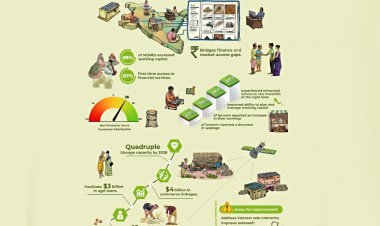ECONOMIC SURVEY: GDP projected to grow in the range of 6-6.8% in FY24
Union Finance Minister Nirmala Sitharaman Tuesday tabled in Parliament the Economic Survey 2022-23, which projects India to witness GDP growth of 6.0 per cent to 6.8 per cent in 2023-24, depending on the trajectory of economic and political developments globally, and forecasts a baseline GDP growth of 6.5 per cent in real terms in FY24. The projection is broadly comparable to the estimates provided by multilateral agencies such as the World Bank, the IMF, and the ADB and by the RBI, domestically

Union Finance Minister Nirmala Sitharaman Tuesday tabled in Parliament the Economic Survey 2022-23, which projects India to witness GDP growth of 6.0 per cent to 6.8 per cent in 2023-24, depending on the trajectory of economic and political developments globally, and forecasts a baseline GDP growth of 6.5 per cent in real terms in FY24.
The projection is broadly comparable to the estimates provided by multilateral agencies such as the World Bank, the IMF, and the ADB and by the RBI, domestically.
The Survey says, in real terms, the economy is expected to grow at 7 per cent for the year ending March 2023. This follows an 8.7 per cent growth in the previous financial year.
Despite the three shocks of COVID-19, Russian-Ukraine conflict and the Central Banks across economies led by Federal Reserve responding with synchronised policy rate hikes to curb inflation, leading to appreciation of US Dollar and the widening of the Current Account Deficits (CAD) in net importing economies, agencies worldwide continue to project India as the fastest-growing major economy at 6.5-7.0 per cent in FY23, explained Chief Economic Advisor V Anantha Nageswaran at a press briefing later.
Economy has nearly recouped what was lost, renewed what had paused, and re-energised what had slowed during the pandemic.
The Survey, mainly a review of how the economy fared in the past year, with certain projects for the next fiscal, was presented in both Houses of Parliament by the Finance Minister ahead of the Union Budget to be presented on Wednesday.
According to the survey, India has become the world’s fifth largest economy and the nominal GDP of India will be around 3.5 trillion US dollars in March this year. The survey stated that the rise in consumer prices has slowed considerably. According to the survey, the annual rate of inflation is below 6 per cent and wholesale prices are rising at a rate below 5 per cent. The export of goods and services in the first nine months of the current financial year is up 16 per cent compared to the same period in 2021-22.
The forecast in the government's annual Economic Survey report is higher than the International Monetary Fund's projection of 6.1%, because the report's finance ministry authors expect strong domestic demand to partly offset global weakness.
"The actual outcome for real GDP growth will probably lie in the range of 6.0% to 6.8%, depending on the trajectory of economic and political developments globally," it said. The government has estimated GDP would be 7% higher in 2022/23 than last financial year, when the economy showed growth of 8.7%.
The survey said inflation was not high enough to deter private consumption nor low enough to weaken investment, even though it remained above the central bank's target range of 2% to 6% in 2022/23. Consumer prices in December were 5.72% higher than a year earlier.
The survey said the current account deficit might stay high, because a strong local economy would support imports while exports eased due to weakness in the global economy.
India's current account deficit was 4.4% of GDP in the July-September quarter, higher than the 2.2% of the previous quarter and the 1.3% of a year earlier. Rising commodity prices and a weak rupee caused it to widen.
The survey said the pace of price increases is not high enough to deter private consumption or low enough to weaken investment, even though it remained above the central bank's inflation target in FY23.
The survey noted that "the current account deficit (CAD) may continue to widen as global commodity prices remain elevated, but the economic growth momentum stays strong. If CAD widens further, the rupee may come under depreciation pressure. However, the overall external situation will remain manageable." "India has sufficient forex reserves to finance CAD and intervene in the forex market to manage rupee volatility," it said.
The survey also added that the downside risks to the global economic outlook remain elevated as inflation persists in advanced economies and the central banks are expected to keep raising the key interest rates.
"Challenge to rupee depreciation persists with the likelihood of further interest rate hikes by the US Fed," it said. It added that borrowing cost may remain "higher" for a longer period and entrenched inflation may prolong the tightening cycle.



 Join the RuralVoice whatsapp group
Join the RuralVoice whatsapp group









































